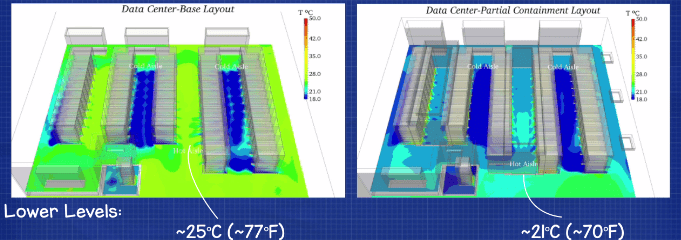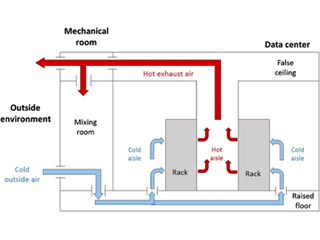Hot and cold aisle containment is a strategic layout for organizing server racks and other IT equipment within a data center. The primary objective of this approach is to enhance cooling efficiency, leading to improved energy consumption and reduced cooling costs through effective airflow management.
Hot and cold aisle containment involves aligning server racks in alternating rows, with cold air intakes facing one direction and hot air exhausts facing the opposite direction. The rows with rack fronts are known as cold aisles, and they are positioned to receive cold air from the air conditioner output ducts. In contrast, the hot aisles face the direction of air conditioner return ducts.
To maintain separation between hot and cold aisles, containment systems are employed. These systems were initially physical barriers using materials like vinyl plastic sheets or Plexiglas covers. However, modern solutions include plenums and Variable Frequency Drives (VFDs) to further prevent the mixing of hot and cold air through control of air pressures.
Best Practices for Hot and Cold Aisle Containment
Efficient airflow within the containment system is crucial. Some setups use in-row coolers to direct cold air directly into the cold containment aisles. Alternatively, raised access flooring can be implemented, where cold air is ducted through the floor and released through perforated tiles in the cold aisle containment area. These perforated tiles should have a high cubic feet per minute (CFM) airflow capacity, with up to 600 CFM being the ideal.
Cold Aisle Containment
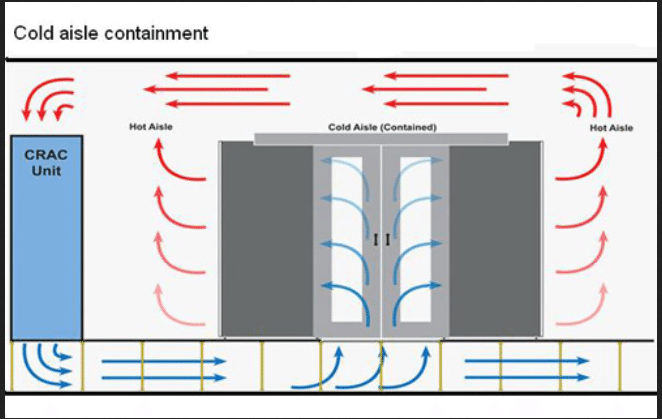
Photo Credit: newsletter.icto.um.edu.mo
Benefits of Cold Aisle Containment
Cold aisle containment offers various benefits, including ease of implementation without the need for additional architectural modifications to manage exhaust air. It simply requires the installation of doors at the aisle ends and a roof. This makes it a cost-effective and adaptable choice for retrofitting existing data centers, especially those with overhead obstructions like existing ductwork, lighting, power systems, and network distribution.
Challenges of Cold Aisle Containment
Utilizing a cold aisle system results in the rest of the data center becoming warmer, potentially affecting workers’ comfort. Properly matching equipment thermal requirements with the containment aisle is essential to avoid wasting energy by overcooling certain equipment. Leakage of conditioned air from equipment openings can also reduce system efficiency. Full cold aisle containment necessitates the installation of fire detection and suppression systems (FDAS) in the separate space.
Matching the equipment thermal requirements with the containment aisle. If there is a lot of equipment in an aisle that can operate at 25°C but there is one piece of equipment that needs 20°C you will be wasting energy over cooling most of the equipment. This reduction in supply air temperature also reduces the economic benefits of the containment system.
Hot Aisle Containment
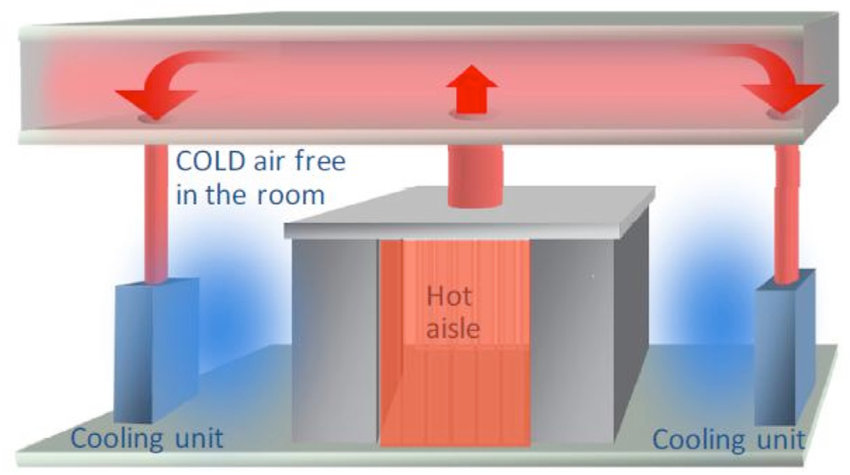
Photo Credit: www.researchgate.net
Benefits of Hot Aisle Containment
In contrast, hot aisle containment floods the data center with cold air and is generally considered more effective. Leaks from raised floor openings are directed into the cold space, eliminating the need for raised floors. Hot aisle containment is particularly suitable for network racks and standalone equipment located outside the containment system.
Challenges of Hot Aisle Containment
Hot aisle containment systems are typically more costly compared to cold aisle containment systems and require a specific path for air to flow from the hot aisle to the cooling units, often involving a drop ceiling as a return air plenum. Higher temperatures in the hot aisle can pose discomfort for technicians working on IT gear. While modern server manufacturing has made servers front-serviceable, hot aisle containment still requires evaluating electrical outlets, fire suppression, lighting, and other systems for their ability to operate at higher temperatures.
Work Environment and Containment Aisle

It is crucial to maintain a suitable temperature inside the work environment according to OSHA regulations or ISO 7243 guidelines, regardless of the containment system used. In cold-aisle containment, the general working area becomes the hot aisle, whereas, in hot-aisle containment, the working area becomes cold. Work environment regulations can be met even if the hot aisle remains closed, as staff is not permanently assigned there.
Allowing the hot-aisle temperature to get too high with cold-aisle containment systems can be a cause for concern for IT personnel who are permanently assigned inside. Meanwhile, for hot-aisle containment systems, the high temperatures in the hot aisle behind IT racks can be mitigated. This is done by momentarily opening the aisle to let cool air in. However, work environment regulations can still be met even if the hot aisle remains closed because the staff is not permanently assigned in the hot aisle. Furthermore, most operations usually take place in front of the IT rack. This leads to a maximum WBGT of 90°F or 32.2°C due to the work or rest regimen of 25% work/ 75% rest, allowing the temperature of the hot-aisle containment system to get as high as 117°F or 47°C. The key difference between the hot aisle containment system and the cold aisle containment system is the higher temperature allowed with the hot aisle containment system since this allows the CRAH units to have more efficient operations.
Monitoring with AKCP Thermal Maps
No system is perfect, and monitoring sensors should be in use to provide ample warning in the unlikely event that a hot spot begins to form. Of course, the AKCP monitoring solution provides data to data center operators to have critical information necessary to increase their efficiency. AKCP Monitoring can predict needed preventive maintenance and actions, such as filter replacement, which help ensure the cooling system is operating efficiently.
Thermal Map Sensors
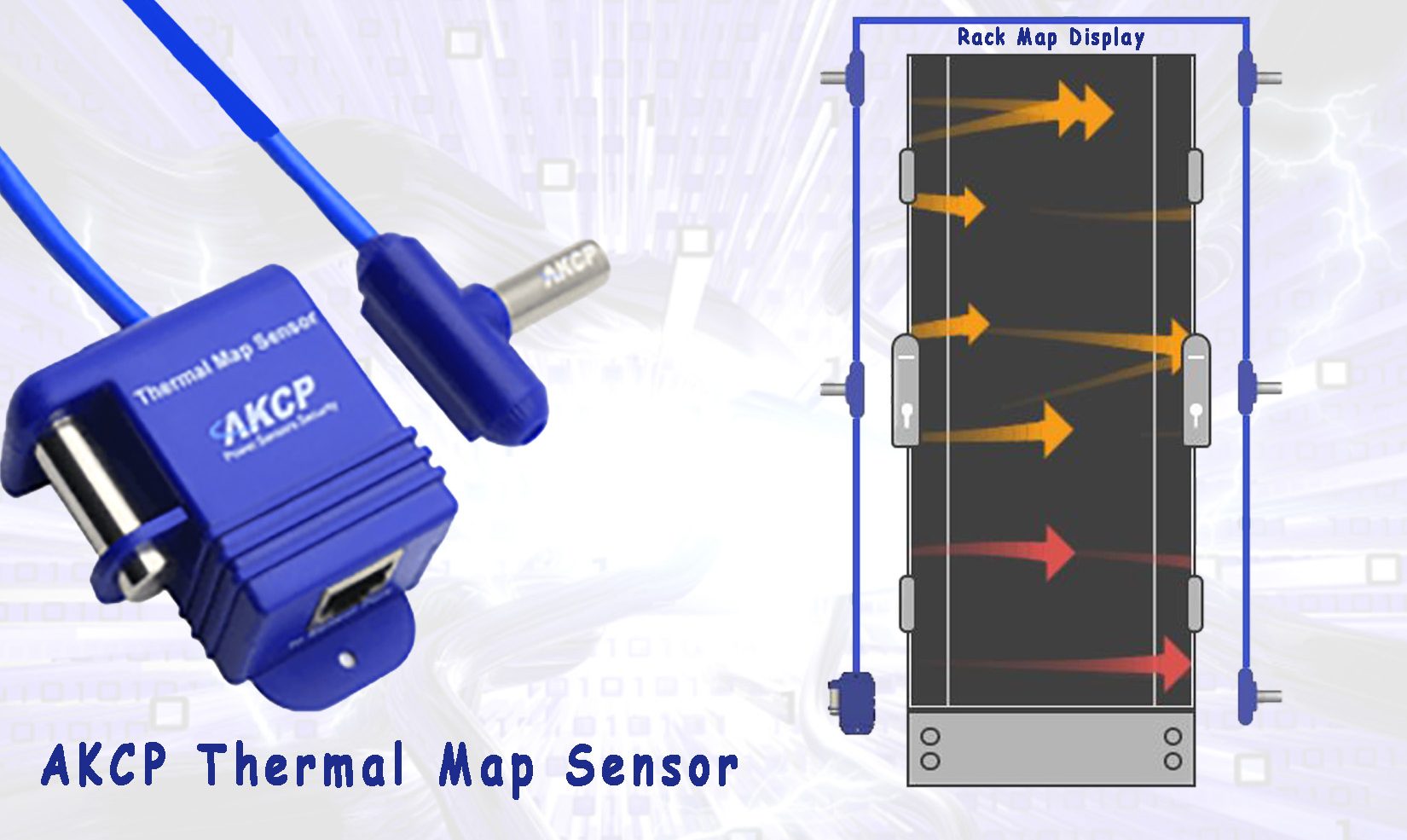
Obstructions Within the Cabinet
Conclusion
Due to high costs and added energy consumption, many data center professionals are considering hot and cold aisle containment strategies. Preventing the mixture of hot and cold air is seen to be one of the most promising energy-efficient measures available for data centers today. Additionally, containment also allows for consistent IT inlet temperatures, and it eliminates hotspots that are usually present in uncontained data centers.
Reference Links:
https://searchdatacenter.techtarget.com/definition/hot-cold-aisle
https://www.missioncriticalmagazine.com/ext/resources/MC/Home/Files/

